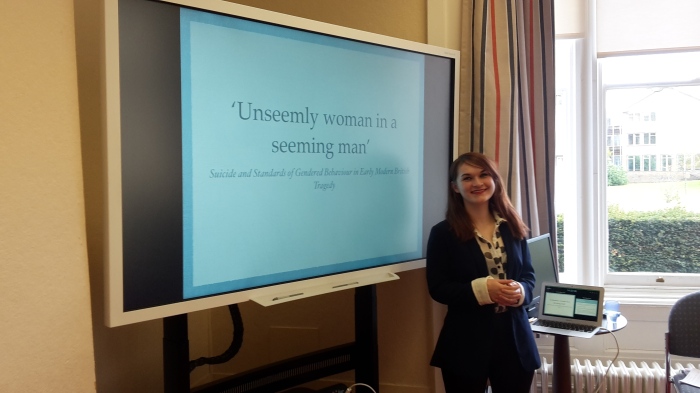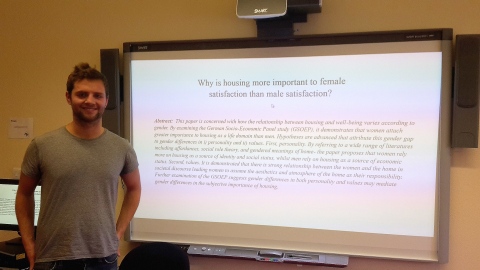Meetings: Academic Year 2014-2015
First Meeting: 5th February
Welcome to the Gender and Sexuality Research Network!
The first ev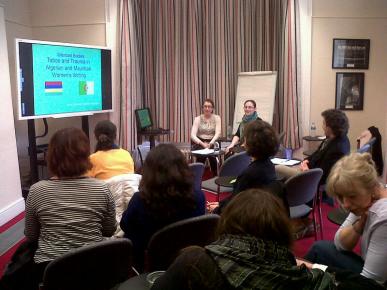 er meeting of the Gender and Sexuality Research Network was attended by around 15 graduates and lecturers. Maria presented a paper on her thesis which shared its title ‘Taboo and Trauma in Algerian and Mauritian Women’s Writing.’ Her paper focussed on two novels which told stories of sexual abuse. She examined the nature of this sexual abuse, how it affected the victim’s psychology and perception of their bodies and whether these young girls were able to heal from their trauma. Afterwards, there was a lively question and answer session where academics and students from Modern Languages, English, Politics and English literature asked questions about the thesis as a whole and suggested some relevant theory they believed would enlighten the project. Since then Maria has been exploring some of the suggested literature and has found some interesting new insights into her project.
er meeting of the Gender and Sexuality Research Network was attended by around 15 graduates and lecturers. Maria presented a paper on her thesis which shared its title ‘Taboo and Trauma in Algerian and Mauritian Women’s Writing.’ Her paper focussed on two novels which told stories of sexual abuse. She examined the nature of this sexual abuse, how it affected the victim’s psychology and perception of their bodies and whether these young girls were able to heal from their trauma. Afterwards, there was a lively question and answer session where academics and students from Modern Languages, English, Politics and English literature asked questions about the thesis as a whole and suggested some relevant theory they believed would enlighten the project. Since then Maria has been exploring some of the suggested literature and has found some interesting new insights into her project.
Thanks again for attending! it was wonderful to see so many of you and hear your thoughts on the paper.
*
Second Meeting: 30th April
‘Unseemly woman in a seeming man!’ 30th April
Thank to everyone who came to our meeting today in the graduate school. Thanks especially to Yasmin Bell from the Department of Film, Theatre, and Television studies for her fascinating presentation on the gendered representation of suicide in British Tragedy. The paper sparked an interesting debate on gender roles in society during which we discussed how these are defined and constructed. We also compared how suicide was portrayed in Shakespearean tragedy with how it is depicted in the press today. Finally, we discussed the term ‘monstrous woman’ and why society portrays femininity as monstrous.
We wish Yasmin the very best for her MRes dissertation!
We really enjoyed Yasmin’s paper and we hope to see you all again for the next meeting in May which will be advertised here very shortly.
*
Third Meeting: 28th May
Gender Identity in the Mosaics of Roman Spain: 28th May
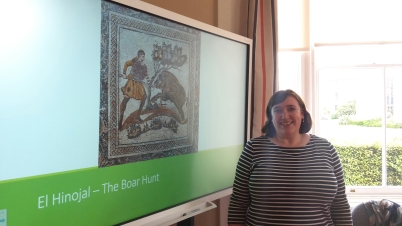
Thank you to everyone who attended the gender and sexuality research network meeting yesterday. It was a very inter-disciplinary group who came along to see Lucy’s paper on the mosaics in Roman Spain. We had attendees from archeology, politics, philosophy, modern languages and even business studies! Everyone engaged with Lucy’s fascinating presentation on the representation of masculinity in the beautiful mosaics on which she is basing her research. I (Maria) particularly liked the anthropological angle Lucy is taking on these mosaics by questioning for whom these mosaics were commissioned and what message the owners were trying to portray to those who saw them. We had a lively discussion after Lucy’s paper about the mosaics which included suggestions from those present who study politics for Lucy to consider some discourse theory as a way of interpreting the mosaics. We considered the significance of where these mosaics were placed in the Spanish villas and who witnessed them; whether it be the esteemed guests of the owners or their servants who washed the floors.
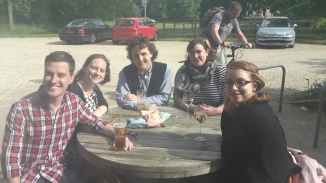
The discussion continued in the pub on campus afterwards. We discussed Lucy’s paper and some ideas about how to build on the success of the Gender and Sexuality Research Network during the next academic year. Watch this space!
Thanks again to everyone who attended and in particular Lucy for coming all the way from Bristol to give her insightful paper. Yesterday’s meeting was the last of this academic year. We look forward to seeing you all again in the Autumn Term. If you would like to present a paper next year please contact us and we will book you in. Keep your eyes on the blog as we may be posting articles from time to time on gender and sexuality. If you would like to contribute a piece, please contact us.
Bye for now! Have a great summer!
* * * * * * *
Meetings: Academic Year 2015-2016
First Meeting:
“Why is housing more important to female satisfaction than male satisfaction?” 22nd October
Thanks to everyone who attended October’s Gender and Sexuality Network meeting!
And… to Chris Foye, of course, for his fascinating paper!
For the first time we were treated to a paper by a PhD student from a non Humanities background. Chris Foyes’ paper examined a data set from Germany and drew conclusions on the relationship between gender and the importance of housing. For example, he drew parallels between the importance of housing for men with or without children, stating that the former considered housing to be far more important than the latter. For women, however, there was no change in their attitudes to their home when they became mothers. His paper lead to a series of questions about the role of a woman’s age in her satisfaction towards her house and also whether marital status was an important factor. The organisers of this group, Maria and Sophie, also questioned whether sexuality played any role in the importance people assign to their housing. We were unsurprised that data from the 90s did not include any statistics on this. Yanos Soubieski, who will be presenting at our next meeting on the 26th November, asked whether attitudes towards housing in the former East and West Germany had reflected the historical changes in the two regions. Chris responded that this was a very interesting question and that he would bear this in mind in the chapter upon which his thesis is based. Cultural comparisons were also made between German, English, Greek, French, and Arabic speaking nations. The audience offered their personal experiences of the ways in which male family members’ attitudes towards their home environment differed from female family members’ attitudes. According to the attendees’ experiences, it often seemed to be the case that the men viewed their houses more in terms of an investment than did the women, putting less emphasis on the appearance of the inside of the house than the women.
Second Meeting:
Seminar Meeting Report, 26th Nov
The paper this week was given by Yanos Soubieski, a doctoral researcher in the Department of Politics and International Relations, titled: “What’s Wrong with Marxist Feminism? An Althusserian Alternative”. We had a great turnout and a real range of questions in the discussion.
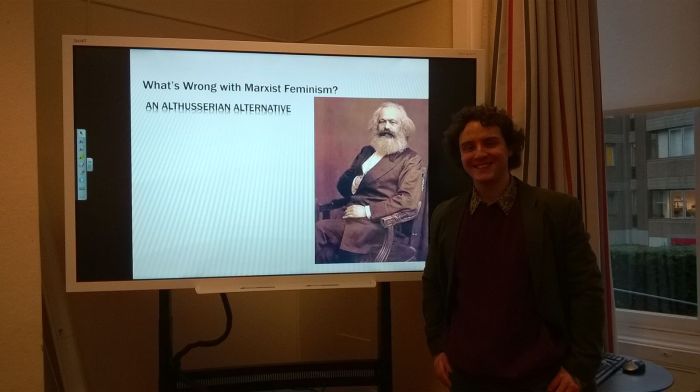
The first half of Yanos’s presentation was centred around criticisms of Marxist feminism. Feminist readings of Marx identify the relations of dominance and abuse that (can) develop from a division of men into the public sphere of production and women into the private sphere of reproduction, that is, producing and raising either female children, who can then also reproduce, or male children, who can enter the workforce, once they have become adults. By being limited from entering the sphere of production, women’s earning potential is severely reduced and they are put into a relationship of dependency on men. Within readings like this, sex antagonisms are reducible to class antagonism caused by the phenomena of private property in capitalism. Yanos highlighted how this is inadequate for understanding patriarchy (loosely understood as a society characterised by male domination over women), because women occupy a lower position according to men in all classes, meaning that dynamics of relations between men and women must be operating independent of, at least to some extent, economic factors. Additionally, patriarchy can be found in non-capitalist societies, such as pre-capitalist societies, and supposedly post-capitalist societies such as in the Soviet Union.
To address these criticisms, Yanos put forward the alternative theory that he is developing in light of recently (2014) published manuscripts from Louis Althusser, a Structural Marxist who was writing most prolifically in the 1970s. Althusser, while not looking at patriarchy, develops a theory of subject formation which lessens the economic determinism in traditional readings of Marx. What we understand as society is a composite formation of different structures, such as the media, the school, the family, each of which attempts to maintain its own stability through ideological interpellation. We become subjects (that is, who we understand ourselves to be) through our recognition of ourselves in relation to an external Other. In a crude summary of Althusser’s example, when a policeman hails us out on the road and we turn around, we have become a subject because we have realised that the policeman is talking to us and that we are obliged, through our relationship with the policeman, to listen to him and turn around. Yanos identifies the family structure as the primary location of subject formation, as we are interpellated as subjects by our parents and the rest of the family before we are even born. This is a crucial point for Yanos’s application of Althusser to patriarchy, because sex plays a key role in subject formation of a new child, such as the name chosen, the pronouns used to describe the child, without even going into clothing, toys and the decoration of the nursery.
A range of points were brought up in the discussion, such as Vicky, an external visitor from Cardiff, sharing her personal experience from Cuba. Cuba is ostensibly a Communist country, but still has prevalent sexism and sex divisions, which backs the criticism of Marxist feminism that sex antagonisms operate in a different way to class antagonisms. Dr Andreas Behnke highlighted that woman and men are not so clearly divided as they once were, with women visible and active in the workforce. Yanos countered this with the observation that women still suffer from inequality, being on average paid less, occupying a minority of high-level positions and occupying a majority of part-time and other precarious job roles compared to men. Patriarchy continues to have a strong presence in the ordering of society, despite the decades of protest and efforts for change for women. A subsequent more general Marxist response to this would also be that a solution is not to open up the exploitative capitalist workplace to women as well as men, but to remove the exploitative structure in the first place.
We thank Yanos for giving his paper and engaging with the discussion afterwards. The next seminar will be on Thursday 3rd December at 1-2pm in G09, given by Monica Palmero Fernandez of Archaeology on “The Realm of Goddesses in Ancient Mesopotamia”. We look forward to seeing you there!
Seminar Meeting Report 03/12 “The Realm of Goddesses in Ancient Mesopotamia”
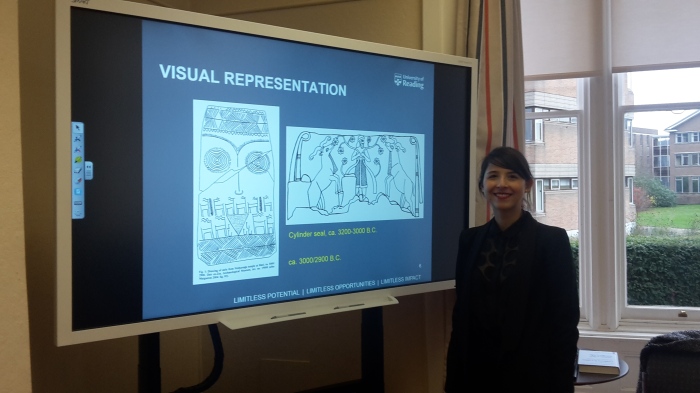
Monica Palmero Fernandez’s insightful paper introduced us to the ancient land of Mesopotamia (Iraq and Syria in the modern day) and the significance of goddesses in the cultural context of this society. She provided us with various visual representations of the goddesses which included drawings of these figures in human, symbolic, and animal form. Monica explained the complex gender identity of the gods and goddesses, stating that the same gods/goddesses were sometimes represented as male in one depiction and female in another. Their sexualities were also complex and did not reflect sexual norms in Ancient Mesopotamia. Monica connected the powers attributed to the goddesses by the ruling elite to the power structures this elite wished to enforce in the society they governed. For example, kings would write poems declaring their relationships to various deities throughout their lives in order to legitimate their royal status. She ended her paper by discussing the complexities of grappling with her methodological approach to written and visual depictions of the goddesses, which included looking at intersectionality and queer theory.
After her paper, the discussion centered around the role of elite women in male dominated Mesopotamian society, the link between the goddesses and nature, as well as the lack of sources describing the lives of members of society at the lower end of the hierarchy. Furthermore, Monica explained the difficulty in determining the gender of these goddesses from the Sumerian language because it does not have masculine and feminine pronouns or articles.
Maria and Sophie would like to thank Monica for her delightful paper and everyone else who attended our final seminar of 2015. We hope to see you next year for our very first paper which will take place on Thursday 14th January. It will be presented by Carl Gibson from the Politics and International Relations department. He will be providing us an insight into his fieldwork in Palestine.
Have a wonderful winter break!
Fourth Meeting:
Seminar Meeting report 14/01 “Gender and Knowledge of Terrorism in Palestine”
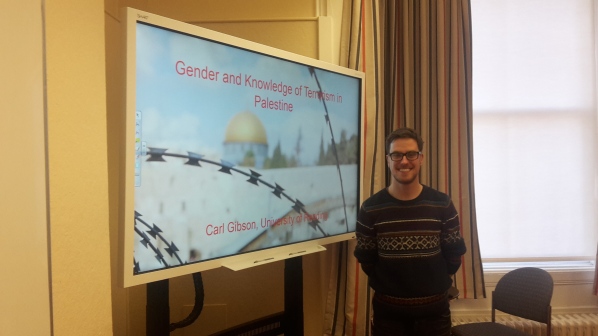
Thanks to everyone who attended Carl Gibson’s talk on his fieldwork in Palestine. It was fascinating to hear about his varied experiences with interviewing local people and the information he has gathered from doing so. Carl discussed the difficulty in defining the word ‘terrorism’ and the varying use of the word in the Western and Arab media. He has discovered that media and internet discourse on terrorism is highly gendered. He noted that there is much more written about the lives of female terrorists and their motivations than on male terrorists. The sources mentioned often linked the women’s involvement with terrorism to a trauma in their past, such as the death of a child, rather than to political motivations. Yet, Carl suggested there was more of a taboo around these female terrorists as almost all of the posters he has spotted in Palestine were of male martyrs (شهيد / shahid) rather that female ones (شَهِيدَة/ shahida).One woman in particular, named Hadeel al-Haslamun has featured on the occasional poster, despite it being unclear whether her refusal to remove her niqab at the Palestine Israeli border was for political reasons.
The discussion after Carl’s paper revolved around the escalation of violence in Palestine and women’s involvement in such violence. We also debated why in war women and children are treated as victims and men often are not and why how this linked to a lack of biographical information on the internet about male terrorists. As well as discussing the lives of the shahida in more depth, we also discussed the practicalities of Carl’s research in such a dangerous part of the world. It was clear that his many years of living in Palestine were vital to his success in finding interviewees and conducting his research successfully. We wish him all the best for his return to Palestine at the end of the week!
Academic Year 2016/2017
Illusion of Influence? Yemeni Women in Power: Meeting Report 03/09/2016
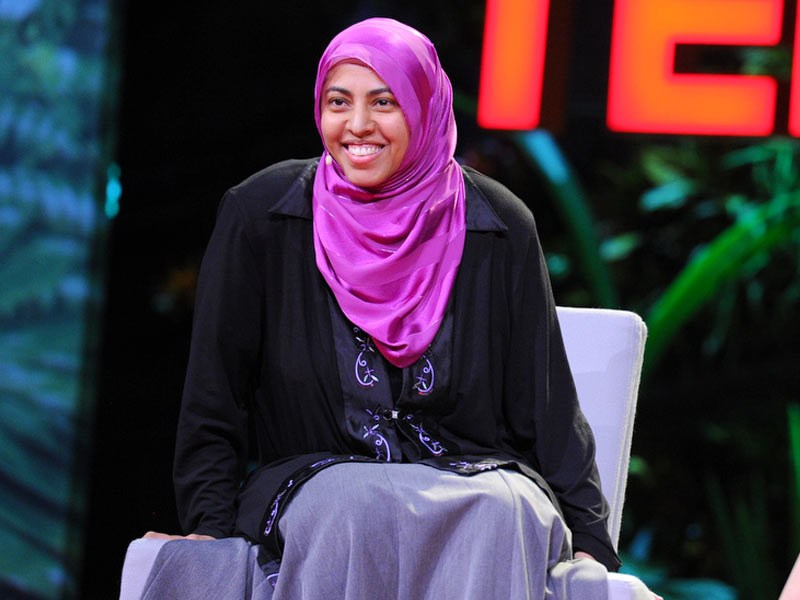
Today was a very special occasion indeed! We welcomed the very accomplished Nadia Al-Sakkaf who told us all about her research on Yemeni Women. It was wonderful to hear from someone who has such a wealth of personal experience which relates to her own research. Nadia was editor in chief of the Yemen Times and former minister of information. Read more about her remarkable story here.
Nadia set the tone for her paper by asking why female politicians in Yemen have not been able to improve the lives of women despite their increasing numbers in parliament. With the Gender Gap Index behind her, Nadia problematised the correlation between increasing representation of women in government and improvement in equality. She asked why some African countries such as Rwanda had scored highly in the Gender Gap Index and yet there is still a long way for them to go in terms of equality.
Nadia told us fascinating stories about women she has met in Yemen who are in high powered positions yet still have limited freedoms such as giving their husband some of their salary and not being allowed to travel abroad without a chaperone. She added that condescending attitudes towards women in important positions are also common. Nadia declared very poignantly that women such as herself who are (or who have been) in high positions “feel disempowered by being empowered”. This begs the question of how women can become empowered in Yemen and beyond… As we discussed in the Q and A, there is no simple answer. Clearly, the political structures in place need to change and, of course, education for girls must be a priority.
Thank you very much to everyone who attended this illuminating talk. We hope to see you again on the 17th October!
Report by Maria Tomlinson
Is Jealously a Good Reason to Pursue Sexual Monogamy? Report: 17th October

Well, that was a very controversial seminar indeed! Thanks to all who attended – was fantastic to see such a packed room.
Nick’s talk on jealousy and monogamy was intriguing -certainly a different tone from our previous papers. He was very keen to outline his personal vision for humankind – that of a world without monogamy. His passion was clearly evident in his enthusiastic delivery. Nick argued the merits of non-monogamous relationships and discussed the role which jealousy can play in monogamous relationships. He questioned whether this feeling could be managed through partaking in non-monogamous relationships. He even delighted us with some personal anecdotes about Grinder (nicely leading us into our talk next week)!
After Nick’s paper we had our most lively debate yet! Members of the audience asked Nick whether he had considered the feminist arguments and the role of society in promulgating certain gendered stereotypes. He was also asked what he believed the role pornography has played in defining sexual relationships. We also asked him to consider his argument from an LGBT perspective.
We wish Nick the best of luck with his project!
Meeting Report: ‘Embodied Offline to Online Interactions: New Media and Body Practices in Urban Space’

Thank you to lecturer Phevos Kallitsis for coming all the way from Porstmouth to talk at our Gender and Sexuality meeting. It was really interesting to hear how apps such as Grindr have impacted the experience of the gay community in Portsmouth.
Using data from his research, Phevos superimposed mapping information gleaned from Grindr over a map of the city of Portsmouth to demonstrate how the gay community is spread over the city. He discussed the changing scene in Portsmouth, informing us that the number of gay men in the city has shrunk in recent years (hence the same profiles reappearing again and again on Grindr). Yet, the lesbian community is still thriving which is evident in their yearly Pride celebrations on the streets of the city. He added that his data demonstrated that Portsmouth occasionally hosts gay tourists who enter via the port. This movement can be tracked on Grindr, since it displays a sudden gathering of gay men in the same area who are interested in meeting someone other than the same local faces they encounter daily on Grindr.
It was sad to hear that there is now only one gay bar in Portsmouth, but Phevos did not believe that Grindr was to blame and stated that it was more a resistance to commercialization since cruising areas maintained their popularity. He also made some very interesting points about the blurring of the public and private space. He explained that Grindr is not the safe haven it appears because users can deploy the app to blackmail other users who have still not come out to their family and friends.
Sophie and I (Maria) would like to thank everyone who attended. We look forward to seeing you all again at the next meeting on the 7th November at 4pm in HumSS280. The paper is by Elizabeth Kajs from the History of art department at University of Bristol. The title is ‘Connecting Creativity and Reproduction in Kãthe Kollowitz’s Artistic Practice’. Abstract to come soon!
Meeting Report: ‘Motherhood at the Centre: Connecting Creativity and Reproduction in Käthe Kollwitz’s Artistic Practice’

We’d like to thank Elizabeth Kajs for coming all the way from Bristol to our network meeting today. It was wonderful to hear a bit more about Elizabeth’s research and how it has progressed since she presented at the Gendered Spaces symposium in May (organised by the Gender and Sexuality cluster).
Elizabeth contextualised Kollwitz’s art in the political climate of late 19th and early 20th century Germany. She explained that women were seen as the guardians of tradition, were expected to behave passively, as well as assuming the role of the nurturing mother. Kollwitz’s art subverted these ideals of the 3rd Reich and protested against the poor conditions in which the proletariat lived. Elizabeth highlighted the controversial nature of Kollowitz’s art in her portrayal of subject matter such as unwanted pregnancy and domestic abuse. Kollwitz explored these issues in the lives of the working class and took inspiration from the medical records kept by her husband who was a doctor.
The Q and A included a discussion on the reaction of the Third Reich to Kollwitz’s work, its dissemination (such as in a pro abortion pamphlet), the artistic movement into which she fitted best (Elizabeth explained that Kollwitz didn’t fit into any specific tradition but shared some tendencies with naturalism), and her aiding progressive movements through her art (such as drawing an image of a pregnant impoverished woman which was used in a pamphlet produced by an anti-abortion campaign).
Thanks again to everyone to coming along to yet another fascinating paper. We’ll see you next time on the 14th November for Lubna Bahamman’s paper on Saudi Women on twitter.
Report by Maria Tomlinson
Meeting Report: ‘Investigation of Gendered discourses on Twitter about Saudi Women’s Issues’ 14th November

Thank you to all of you who attended Lubna Bahamman’s talk today – it was great to see so many of you! Lubna’s paper was a wonderful insight into how Saudi women are represented on Twitter either by themselves or by men. She highlighted the popularity of Twitter in Saudi Arabia and revealed that the majority of users were in their twenties. She also set the tone of her paper by emphasising the misconceptions of Saudi women’s freedoms and lives that are often all too evident in the Western Press.
After providing some context about Saudi Arabia and its laws, in particular those that came into force post 2001, Lubna gave two particular hashtags as an example of the linguistic research she is undertaking. These were: (in translation from Arabic) #newtravelcontrolsforSaudiwomen and #onethirdofSaudiwomenarespinsters. She focused on the first hash tag and explained how a piece of news about women needing the permission of their guardians to renew their passports was misappropriated into an argument about women being allowed to travel on their own. She explained that 63.8% of tweets using the hashtag were by profiles claiming to be women. She also outlined that women were most likely to use laughter and emoticons in the tweets and men were more likely to quote from religious texts. One tweet Lubna showed us was written by a 50 year old woman who was protesting the fact that she is not allowed to travel abroad to medical conferences without her young son’s permission (as her guardian).
Our Q and A included a discussion about women’s opportunities in Saudi Arabia and where such debates about women’s rights took place before Twitter. Lubna highlighted the revolutionary nature of the space Twitter has provided for Saudi men and women because it is it is accessible to them both. Before Twitter, the only place where women could debate such issues with men was within their families.
Thanks again to all who attended and especially to Lubna!
See you next week for a talk on ‘Syrian Men and the Humanitarian Response to the Refugee Crisis in Jordan’ by Lewis Turner from the Politics department at SOAS.
Meeting Report: ‘Thinking Beyond ‘Refugee Women and Children’: Syrian Men and the Humanitarian Response to the Refugee Crisis in Jordan’ 21st November

Hello everyone!
Firstly, a large thank you for Lewis Turner for coming to Reading from SOAS to give us a very insightful and topical paper. Secondly, thanks again to everyone who attended – wonderful to meet new members and see our regulars again. It is very difficult to sum up, in a short blog piece, all of the nuances of Lewis’ talk but one will do one’s best!
Lewis’ paper was based on his field work in Jordan where he interviewed both workers in the humanitarian sector and refugees. Many of these interviewees welcomed his interest in the way in which male refugees are viewed by the humanitarian sector since it is rare that anyone takes any notice of them apart from in the cases of research into preventing sexual violence. Lewis even gave an example of a photographer he met who did not bother to photograph men because he knew only photos of women and children refugees would be printed.
Lewis explained that women and children refugees receive the majority of funds and care by NGOs because it is a widely held belief that they are more vulnerable than men. Lewis outlined that the Humanitarian sector falsely assumes that female-headed households are more vulnerable than male-headed households. He said that, in fact, data actually prove the opposite by demonstrating that the latter are slightly more likely to be living in poverty. Lewis underscored the importance of challenging these assumptions so that vulnerable men also receive much needed help. He proposed that the assessment of a refugee’s vulnerability should not be allocated based on gender but on the refugee’s circumstances. For example, he explained that refugee men in Jordan are often vulnerable to police harassment and to being forcibly encamped. He added that Syrian men he interviewed confirmed that the humanitarian sector took little interest in them and that Syrian women are encouraged to play the victim in order to receive help. He gave an example of a psycho-social support centre he visited in North Jordan in which 17 female and one male councilor worked: the male councilor, of course, was booked for weeks on end. This striking example clearly illustrates that this balance needs to be addressed!
In the Q and A session there were many poignant questions for Lewis. He was asked what the genesis of the problem is – is the West to blame for this gendered understanding of vulnerability? He argued that the West was indeed partly responsible but that Syrian men also held parallel views that women are far more vulnerable than them. He continued to discuss the lack of intersectionality through which the refugee crisis is viewed. Another attendee asked about the realities of his research and we closed with a question on his recommendations. Lewis recommended an on the ground investigation into the vulnerability of refugees and a subsequent change in vulnerability criteria.
We look forward to welcoming you back next week for our talk by Estella Liang on translating sexuality in Chinese subtitles in Bridget Jones’s Diary. We’re looking forward to seeing how the words of the much loved character of Bridget Jones are conveyed in Chinese. See you next week, 4pm, HumSS280.
Report by Maria Tomlinson
Meeting Report: ‘Whose Heritage is it anyway? Making Space for Amma Asante’s Belle’ 5th December
 Thanks to Sarah Smyth for her fantastic talk on Amma Asante’s Heritage film Belle. It was a really engaging talk and the audience showed their enthusiasm for the subject during the Q and A session.
Thanks to Sarah Smyth for her fantastic talk on Amma Asante’s Heritage film Belle. It was a really engaging talk and the audience showed their enthusiasm for the subject during the Q and A session.
Sarah demonstrated how Belle rewrites the forgotten woman of colour back into heritage cinema which often ignores the contribution made to British society by non white female figures. Sarah introduced us to the character of Belle based on the real life Dido Elizabeth Belle born in 1761 to a black mother who was a slave and white father who was a British Royal Navy officer. Dido lives in a stately home (Kenwood House) with her uncle Lord Mansfield. The film examines the slavery in the 18th century including the Zong Massacre. Dido asserts her privileges as a member of an aristocratic family by influencing her uncle into prosecuting those responsible for throwing the slaves overboard. The film also explores the potential pitfalls of marriage for Dido as she would risk losing her inheritance to her husband. Not only does Belle pose a feminist critique to patriarchal laws of inheritance it also highlights the added obstacle for Dido for whom it would be difficult to find a husband of adequate status because she is mixed race.
Sarah took a few key scenes from the film to investigate how race and women are represented. She focussed on the carriage in which Dido travels from Kenwood house, describing it as a liminal space in which Dido could express her dissent and escape her patriarchal household. Sarah also analysed the relationship between Dido and a black servant, Mabel. Dido asks Lord Mansfield if Mabel is a slave but he responds by explaining that she is under their protection and is a free woman. Dido therefore disrupts the happily family image by bringing questions of class and race to the table and highlights her liminal position as both a privileged wealthy member of society and a mixed race woman. The Q and A afterwards conditioned to delve into the relationship between Mabel and Dido by exploring the intersection between class and race.
Thanks again to Sarah and to everyone who attended! We wish you a happy Christmas and look forward to seeing you in the new year. Look out for our spring term programme – it is jam packed with talks every week!
Meeting Report: ‘Can we hear ‘girlhood’? Female adolescence as musical affect in film’ 16th Jan

Hello everyone!
A big thank you again from Sophie and I (Maria) to Gemma Edney who drove all the way from Exeter to come speak to us. I was keen to hear Gemma speak again after seeing her present in Exeter last year. Thanks again to our regulars who attended and asked some intriguing questions. It was a really enjoyable talk and Q and A. It’s very hard to summerise such a detailed and thoughtful presentation but here are a few highlights…
Gemma explored how ‘girlhood’ is conveyed through music in film. She presented some very interesting theories such as Kristeva’s theory that music is a feminine derivative because it is pre-verbal. It resembles the sounds the baby can hear in the womb which can be interpreted without understanding language. Gemma also spoke about universal signs of girlhood that we immediately recognize including princesses, joy, dresses, and diamonds. Gemma quoted Monica Swindle who says the following about girlhood: ‘Feeling Girl, Girling Feeling: An Examination of “Girl” as Affect’ (2011): “‘Girl’ is certainly a signifier; however, there is now a distinct affect animating and in excess of the signifier “girl” in Western late capitalist societies. This affect, girl, circulates with/among objects, including signifiers, giving materiality to certain collectives of bodies (most often though not necessarily young feminine bodies), rendering them girls, and sticking to certain objects and people to create girl culture. This affect has been appropriated and deployed in contemporary culture by marketers (among others) but also by feminists.”
Gemma explained that there are various musical characteristics that listeners often associate with femininity such as the time signature (three beats per bar), the instruments (such as the flute), and the style (such as soft or even erratic). Gemma focused on the film Bande de filles directed by Céline Sciamma and introduced us to the film Le Herisson. In the latter, each character has their own score to differentiate between them. The older woman (Madame Michel) has a solemn soundtrack incorporating low pitched string instruments and the 12 year old girl (Mademoiselle Paloma) has a more lighthearted soundtrack with piano, strings, and percussion.
On the subject of Girlhood, Gemma demonstrated how the film follows many conventions which signify girlhood with its use of the song ‘Diamonds’ by Rihanna to accompany the main four characters dancing. Rihanna, who often refers to herself as a girl, such as in the song ‘Only Girl (in the World), is seen as a universal symbol of girlhood. Her song was deliberately chosen by the director in order to convey a message of girlhood and the scene was so central to the film it was even recorded before Rihanna gave her permission. Gemma also observed that the original musical score of the film mimics the characters’ behaviour: it is loud and erratic. It is pulsating, percussive and has an uneven rhythm to represent the girl gang’s youth and lack of direction in life.
In the Q and A we questioned what stage in life girlhood ends. We compared it to boyhood which seems to have a more definite ending. An example was given of the film Boyhood which ends when the protagonist reaches 18. We also realised that Gemma’s talk will change the way in which we watch films from now on. I stated that this was now an excuse to watch some of my favourite films again! Legally Blonde anyone?
‘Becoming (S)he: Deconstruction of The Voice in Drag Lip-syncing performance’ – Meeting Report
Hello, hello, hello! (in the voice of RuPaul)

Well, what a fantastic crowd we had for Jacob Bird’s talk on lip-syncing during drag performances. Thanks to everyone for coming and showing your enthusiasm. Rightly so, seeing as Jacob’s paper was very dynamic and engaging. It was fascinating to hear Jacob’s own insights as a drag performer as well as his recounting the interviews he has conducted with other drag queens (one, for example, sees his drag alter ego as his therapist). As a huge fan of drag myself, but also as an academic, I was interested to see how drag and theory could be brought together.
Jacob (aka as Dinah Lux) informed us that lip-syncing has been understudied since it is often perceived in a pejorative light. He announced his intention to prove to us that it is actually much more than just moving your lips in time to a song – and he did! Jacob argues that lip-syncing is a method of self-actualisation both for the performer and the audience. By lip-syncing along to the songs of artists such as Britney Spears, Lady Gaga, and Natalie Cole who have experienced adversity from which they have then bounced back, drag queens can find their own sense of courage and perform their agency. Jacob eloquently stated that, in this way, lip-syncing is a “silent phenomenon of gaining voice”. Drag queens can construct their own identities through identifying with others. Jacob examined the drag queen’s identification with the other through the theories of some of the greatest minds of our time (see photo above): Michel Foucault, Friedrich Kittler, Jacques Lacan (in particular his theory of the mirror stage) and RuPaul. RuPaul tells us that “we’re all born naked and the rest is drag”. (An aside: this quote has been a way for me, during teaching a module on surrealism, of discussing how artists such as Claude Cahun and Marcel Duchamp evoke the constructed nature of gender identity through art.)
There was a very lively Q and A after Jacob’s talk. We questioned whether drag was misogynist or feminist. We also discussed RuPaul’s Drag Race and how it only really shows one side of drag. The drag queens on the show mostly try to look very feminine or “fishy”, whereas there is so much more to drag than looking like a woman. Other drag queens, for example, jostle gender identities by displaying both feminine and masculine characteristics. We continued the conversation at Park House where Jacob revealed that Dinah had impressed RuPaul herself by jumping into the splits during the UK Drag Ambassador competition. Wow!
We’d like to thank Jacob once more for the wonderful talk. If you’d like to hear more about Jacob’s research and experiences as Dinah do check out her TedTalk: https://www.youtube.com/watch?v=bzj1BTdfoeI
We look forward to seeing you next week for our talk on women’s employment and empowerment in Saudi Arabia.
Byyeeeeeee!
Report by Maria Tomlinson
Meeting Report: Employment and Empowerment in Saudi Arabia

Thanks to Mona Almunaiey for her fascinating talk today on women’s empowerment. She examined how gender norms are institutionalised in the labour market in Saudia Arabia. She outlined that Saudi law is based on a patriarchal interpretation of Islam. As an example, Mona spoke of the concept of qiwama which refers to a man’s responsibility to look after a woman. Mona explained that this has been interpreted into a law that women need a male guardian’s approval for purposes such marriage, applying for jobs, and even access to healthcare. For example, a woman’s legal guardian can provide authorisation online either each time she applies for a job or sign that she is authorised for life.
After discussing the gender norms in Saudi Arabia, Mona spoke about life there since King Abdullah came to power in 2005. He was known as a reformist who encouraged the education and employment of women. Under his reign the number of female graduates increased dramatically. He provided incentives for hiring women since many graduated with degrees in 2008 and were looking for work. Foreign workers are often cheaper to higher. One of the reasons for hiring women was economic since foreign workers in Saudi often send money out of the country. Women can now work in most sectors: education, medicine, in beauty salons and as cashiers. However, the work place is highly segregated. Offices have separate entrances for male and female staff, restaurants have male-only and family sections, and banks have separate male and female spaces.
Mona argued that even though women now have more opportunities to work, they are still very much restricted by gender norms. Day care is very expensive and spaces are very limited. Women are still expected to comply by dress codes such as wearing no make-up. It also can be difficult for women to travel to work because there is no public transport, they are prohibited from driving, and it is culturally unacceptable for women to take a taxi. There are also no laws about sexual harassment.
Thanks again to Mona for her wonderful paper and to everyone who attended. We will see you again in two weeks!
Meeting Report: ‘Surviving the English Civil Wars as a Widow’, 20th February, by Hannah Worthen
Hello everyone!
Thank you again to Hannah Worthen for her really interesting talk about widows in England during the 17th century. Thanks also to everyone who attended. It was great to see some more new faces.

Hannah started off her talk in a very novel way by showing us a tweet she had written as part of a challenge to summarise a thesis in less than 140 characters. It read: “Discovering the petitions of Early Modern War Widows in order to better understand women, war and survival throughout history.”
Hannah outlined the profound impact of the civil wars by stating that 7% of the population of England, Wales, and Scotland died between 1642 and 1651 due to fighting in the civil wars as compared with only 0.7% during World War 2. Hannah spoke to us about a variety of primary sources in which widows are represented including pamphlets and petitions (see images on her power point in the photo above). Society viewed widows both as objects of pity but also as a threat since their newfound single status would permit them to sponge off rich bachelors. In addition, they were sometimes viewed as sexually deviant!
Hannah began her documentary analysis by providing some examples of sources in which widows were portrayed by men who were either royalists or parliamentarians. Some of these documents were created in order to highlight the cruelty of the other side. One royalist, B. Ryves, tries to demonstrate the nepotism in parliament by writing that the widows were crying outside parliament whilst subsidies were given to others who were less impoverished. Hannah added that during the civil wars, it was common to find characterisations of England as a widow.
Hannah’s main focus, however, was on the petitions with which women applied either for pensions or for land to be returned to them. These petitions were usually written by scribes who were either relatives or literate members of the parish such as priests. Parish members were often keen to help widows so that they were less of a financial burden to the local community. Hannah explained that the petitions were normally written in the third person and are rather formulaic. Certain phrases crop up repeatedly. For example, many write that they are living off “borrowed bread” and list a number of small children (the word “small” being key) who are now hungry. Hannah provided us with three fascinating case studies of widows from Kent who had applied either for the return of their land or for a pension. My favourite example was Mary Blaithwaite whose husband died fighting for parliament. To fit in with the image of a widow as an object of pity, she refers to a parable in the Bible and uses highly emotive language. After little success with her manuscript, she decided to go to print. Mary Blaithwaite even sent a rather ominous letter to Oliver Cromwell which essentially informs him that he should take pity on her because he would want his wife to be protected if he ever died.
The enthusiasm expressed by our audience during the Q and A was a testament to Hannah’s really fascinating research. If you would like to find out more, follow Hannah on twitter @HannahWorthen
We look forward to seeing you for our talk next week on the female grotesque. It will take place at the different time of 3pm, in a different room HumSS 144
Meeting Report: ‘Reflections on Writing the Female Grotesque’ by Karina Lickorish Quinn

A big thank you to Karina Lickorish Quinn for her fascinating talk at the network. Thanks also to those who attended – it was brilliant to see some new faces alongside our very loyal members.
Karina introduced the group to a variety of theories exploring the subject of the grotesque before treating us to some extracts of both her published and unpublished fiction. She illustrated how her creative process is influenced by her doctoral research and advised the group not to ignore academic writing as a source of inspiration. At the beginning of her talk, Karina defined the grotesque by presenting us with a series of decorative work which depicts human faces interwoven with foliage. This highlighted the hybrid nature of the grotesque and its absurdity. She then outlined the theories which have so far inspired her fictional works such as ‘OÖGENESIS’ which won the White Review short story prize in 2016.
One theory in particular which took a prominent place in the talk was Julia Kristeva’s theory of ‘abjection’. According to Kristeva, the abject is something which threatens stability and order because it disturbs the boundaries between the inside and the outside of the body. It reminds us of our body’s slow decay and eventual death. Examples include pus, menstruation, and excrement. A particular ‘grotesque’ image with which Karina confronted us was the ‘pregnant crone’. Karina showed us a photograph of a model created by Cindy Sherman of an old woman giving birth to an ambiguous string type substance which resembles sausages. She asked the audience how they responded to this ‘abject’ image. When it first appeared on the screen, faces around the room displayed reactions such as curiosity, horror, amusement and repulsion. Karina argued that Sherman’s model would be seen by philosopher Mikhail Bakhtin as the epitome of the grotesque since it is an image of ‘death giving birth’ and ‘decaying flesh’.
It is impossible in a short report to demonstrate the ambiguity, intensity, and intrigue of Karina’s writing so we’ll leave you with an extract she presented to us from ‘OÖGENESIS’ …
“Before the week was out, in an act of extravagant contempt for her mother’s wishes, Georgia had developed two more pairs of nipples – a set on her abdomen and a set on her groin. The sprouting of thick, black hairs followed soon after: from each nipple erupted a stiff, dark tendril so coarse that it resisted any form of depilation. The aestheticians at the beauty salon, who valiantly but vainly applied everything from hot wax to electrolysis, were horrified; but while Jane remained under a dark cloud of humiliation for the rest of the day, Georgia seemed wholly unashamed of her aberrant hirsutism. Quite the contrary: she seemed to get a perverse satisfaction out of standing in front of the mirror and stroking the long black strands, curling them tenderly around her fingers.”
If you’d like to read more about Karina’s creative writing, have a look at her website: https://www.karinalickorishquinn.co.uk/
‘The Medieval Woman in the Western World’ – meeting report

We’d like to say thank you to Marco Prost for his talk on the medieval woman and the western world. It took us on a journey of 12th century adventure – battles, romance, jealousy, adultery and death! What was particularly striking were the parallels that Marco drew between tropes in contemporary romance stories and the lyric poetry of the Troubadours who portrayed courtly love in the 12th century. Marco quoted a poem by Bernart de Ventadorn (Tant ai mo cor ple de joya) and handed us an extract from André le Chapelain so-called Art of Courtly Love (De Amore). In the latter, le Chapelain examines a variety of 12th century stories about courtly love and draws up a set up rules which he believes underlined them. Rules include ‘He who is not jealous cannot love’ and ‘He whom the thought of love vexes eats and sleeps very little’.
Marco informed us that the ‘femme fatale’ figure can also be traced back through time and is present in the myth of Tristan and Iseult. With a jovial expression, Marco added that Shakespeare’s Romeo and Juliette was not at all original – Iseult commits suicide at the sight of a dying Tristan. Such love was viewed by romance writers as the ‘perfect’ love and referred to as ‘amour fine’. A 12th century author, Marie de France, who is known for her ‘lais’ (short stories) explained that perfect love must always end in death.
Another very pertinent part of Marco’s talk was his discussion of consent in 12th century texts. Indeed, ‘consent’ is a rather modern term to use. However, Marco explained that there did appear to be an element of choice for the women depicted in stories such as Tristan and Iseult as the male character desires for the love to be mutual and waits for the woman’s approval before acting. He quoted a lovely line (in translation) from Bernart de Ventadorn’s poem: ‘She holds me in balance like a ship on the wives’, which refers to the male protagonist’s agonising wait for his lover to submit to his desires. Marco subsequently problematised this idea by discussing the prevailing elements of misogyny in 12th century narratives (such as the woman having little time to make a decision). At the time of these writings, marriage was not an act of love but an alliance, and therefore women had little say in choosing their husband. Marco acknowledged that these romances of courtly love were an inversion of the political reality of the time. Nevertheless, this idea of consent reflected the changing attitude of the church. In the 12th century the church started to recognise the wedding ceremony as a sacrament and therefore insisted that the will of both parties was considered.
Thanks again to Marco and everyone who attended, we are back next week with a history talk on mixed race relationships and women’s magazines in 1950s Britain (13th March, 4-5pm, HumSS280).
Meeting Report – “Facing the Hardships”: Mixed Race Relationships and Women’s Magazines in 1950s Britain, by Anna Maguire

Thank you again to Anna Maguire for sharing her new research project with us. Anna has just finished her PhD and is exploring postdoc opportunities. Providing us with extracts from agony aunt pages in Women’s Own and Woman Magazine, she discussed how mixed race couples were perceived in Britain in the 1950s. In 1948 the Empire Windrush docked in London carrying men from Jamaica and marked the first of many recruits from the commonwealth. She explained that in this context of immigration to Britain from its overseas territories, mixed race relationships challenged colonial and racial boundaries.
Usually, the letters in the agony aunt pages were from white women in relationships with black men on subjects such as a girl’s parents not allowing her black boyfriend into the house. Mothers would also write in to question their own attitude to their daughters mixed race relationship. One mother stated that she is happy for her daughter to date her partner, yet she draws the line at marriage. The theme of parental control is a recurring feature both within the context of mixed race relationsips and others – women under 21 were not allowed to marry without their parents’ consent! Differences in religion and class were also raised as a concern.
One interesting example of the time which Anna provided was a letter sent by a white girl who wanted to marry a black widower who was many years her senior. She was unsure how or whether to tell her parents. The agony aunt, rather than challenging why anyone should disapprove of such a relationship, instead confirms the girl’s fears. She advises the girl to wait until she is older since her relationship may just be a crush. The agony aunt underlines that the relationship must be strong enough to survive the social pressure and that mixed marriage is a great risk.
We wish Anna the very best of luck with her project – we look forward to hearing how her research on this interesting topic develops!
We will see you next week for our very last seminar of the academic year 2016/2017. Sophie and I (Maria) will be handing over the running of the network very soon. We’d love to see as many of you as possible for our last seminar in charge, we’ll really miss running the network. The paper is by Mariana Howell, in the English Literature department at Southampton. The title is ‘Experience of Time and Subjectivity in Modtherhood Writing’. We hope to see you there!
Forever the Dark Prince of Hollywood: Walt Disney, Psychobiography and the “Practically Perfect” – Meeting Report
On Monday 9th October the Gender and Sexuality Research Network’s 2017/18 Seminar Series was kicked off by John Whitney presenting his fascinating work on psychobiography and the reading of the films of Walt Disney, in particular, Mary Poppins, the last live-action film produced with the personal involvement of Walt Disney.
John began by asking what it was that Walt Disney wanted to convey with the images of his films. With little autobiographical data existing on Disney, John demonstrated how his work could be analysed by using the theories developed within psychobiography. Using Schultz’s theory of the ‘Prototypical Scene’ and Alexander’s theories of Saliency and Springboarding, John has been able to conduct a psychobiographical analysis of the ‘Lets Go Fly a Kite’ scene towards the end of Mary Poppins, whilst reflecting on the varying, and at times contradictory, biographical materials that have been written on the life of Disney.
John’s analysis had us delving into the life of Disney, in particular, the family conflict he experienced and the relationships he held with key figures throughout his developmental period. Biographers Thomas and Moseley both detailed the close bond Disney had with Hazel George, his studio nurse, and the moment of their final goodbye. Described as an intense, and emotionally charged moment that has lead biographers to interpret the underlying relationship between them differently. Whether the relationship was one of parental replacement, or of romantic feelings, the saliency of the final goodbye renders this a definitive ‘prototypical scene.’
Next John had us considering Disney’s anxiety around his parentage, with Senora Zamora posing as a potential biological mother, and Disney’s relationship with his isolated mother Flora Call. Whilst the former figure is omitted from much of the material on Disney, Call appears distorted in the accounts, though a pervading question was asked in Mark Eliot’s highly controversial biography of Disney, ‘why didn’t his mother stop the beatings?’, the fear of his violent father, Elias, adding an important dimension to John’s psychobiography.
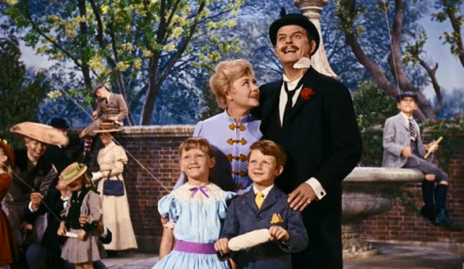
For John, the ‘Lets Go Fly a Kite’ scene in Mary Poppins symbolised the relationship Disney never had with his parents, in particular his father. The reformed Mr. Banks stands over his young son as the caring head of the ideal nuclear family, settling the destabilising force of the maternal figure. Through this prototypical scene, John demonstrated how Disney sought to heal his sense of absent family relations by replacing it with the familial ideal through fiction.
Thank you so much to John for his rich and insightful seminar, and thank you to everyone who joined and helped facilitate a fantastic discussion afterwards at Park House. We couldn’t have asked for a better start to the seminar series, and we are looking forward to seeing you all for our next seminar on the 23rd October when myself (Faye Bird) will be presenting!
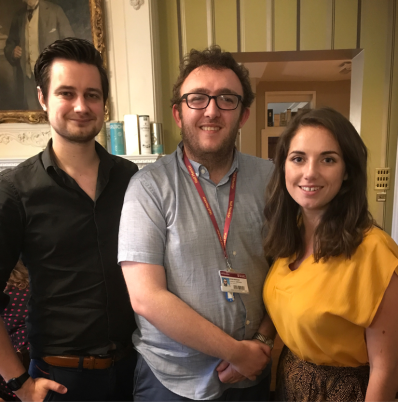
GSRN Coordinator Gareth Mills, John Whitney, and GSRN Coordinator Faye Bird.
John Whitney is a PhD Candidate and Sessional Lecturer researching at the University of Reading within the Department of Film, Theatre and Television. You can contact John via email at J.A.Whitney@pgr.reading.ac.uk for any further information regarding his research.
The Jihadist and the Sex Slave: Gendering the International Discourse on ISIL – Meeting Report
The second seminar in the GSRN seminar series was delivered by none other than network coordinator Faye Bird, who engaged a larger-than-usual audience with a talk on gendering of international discourse on ISIL-Daesh. Being such a high-profile topic on which everyone is familiar, but rarely an expert, the talk served as a rare and valuable insight into a how a law-centred approach to this discourse can take into account new documentation outside the arena of commercial publications and political speeches. Faye suggested that the existing news media narrative in the Western world, whilst sensationalised, also portrays the sexual violence committed by these groups as delineated by strict gender roles, with ‘barbaric’ male perpetrators, female victims and Western male ‘saviours’, despite a far more complex picture on the ground. She proposed that we can significantly enlarge our understanding of this discourse through a qualitative linguistic analysis of the UN Resolutions dealing with ISIL and ‘sexual slavery’ in the region.
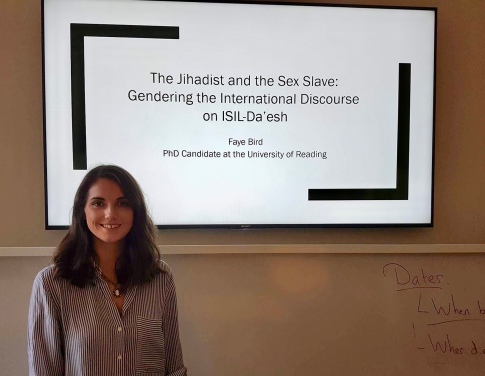 Faye prefaced the talk by showing how the atrocities committed by ISIL are sensationalised and promoted most actively by the group itself. UN Special Representative Zainab Hawa Bangura highlighted this in 2015, when she stressed that the tactic of highlighting the most brutal aspects of crimes against women were a way of ‘institutionalising sexual violence’ and ‘advanc[ing] key strategic objectives (Bangura 2015). This ‘institutionalisation’ is key for the faction’s claim to state-hood, as is the way their own portrayal of their violence becomes a form of propaganda, echoing Chris Weedon’s claim that ‘language becomes an important site of political struggle.’ (Weedon 1987).
Faye prefaced the talk by showing how the atrocities committed by ISIL are sensationalised and promoted most actively by the group itself. UN Special Representative Zainab Hawa Bangura highlighted this in 2015, when she stressed that the tactic of highlighting the most brutal aspects of crimes against women were a way of ‘institutionalising sexual violence’ and ‘advanc[ing] key strategic objectives (Bangura 2015). This ‘institutionalisation’ is key for the faction’s claim to state-hood, as is the way their own portrayal of their violence becomes a form of propaganda, echoing Chris Weedon’s claim that ‘language becomes an important site of political struggle.’ (Weedon 1987).
The talk then moved to the concept of the ‘hyper-masculine’ and the female victim. When politicians such as George Bush comment on how the ‘fight against terrorism’ is a ‘fight for women’, they fall into the discursive pattern described by Gayatri Spivak of a ‘white men…saving brown women from brown men’. (Spivak 1999). Faye pointed out that this binary ontology is problematic both theoretically and factually: in feminist poststructuralist discourse ‘females always adopt multiple subject positions […] it is far too reductive to constitute women simply as victims of male oppression’, a position borne out by the multitude of roles women in the region actually play in sexual violence.
Turning to the opposite end of this scale, Faye suggested that this ‘hyper masculine’ world view is ‘entwined with Sunni fundamentalism, supremacist ideology […] and ethno-sectarian hierarchy’ (Ahram), but that while this is indeed a ‘distinctive form’ of the hyper-masculine, it is not entirely ‘unique’, as Barack Obama had described it in a 2014 speech. Not only are similar acts of sexual violence committed by other groups, but they are even occurring in the same conflict, and against different demographic targets. What makes an act supposedly unique is in fact it’s prominence or visibility, a case which is particularly acute in the case of the ethno-religious Yezidi group.
The well-documented violence against the Yezidi was characterised in media discourse (examples included Metro, The Daily Mail and the Mirror) by an emphasis on ‘sex slaves’ and sensationalised language, privileging the suffering of victims for the most prominent exposure. Faye showed how even in UN Human Rights Council statements this gendered image of what constituted a ‘slave’ did not take into account boys who were effectively enslaved by forced military conscription, or other acts of violence against women who were not targeted for purely sexual reasons, as in the case of mass executions for women over 60.
Faye introduced the concept of ‘Hyper-Visibility’ to describe the Yezidi’s cultural position in the Western world, a term developed by Christine Allison, Veronicas Buffon and Laura Sjoberg. ‘Hyper-Visibility is ‘an insistence or “excess” of visibility, which overloads with signification the object that has been represented […] the object becomes therefore transparent, disappearing behind its broadcast image.’ (Buffon and Allison 2016). Behind the fetishized and symbolic violence against the Yezidi, a host of other crimes exist in a state of relative occlusion, eventually falling into the general backdrop of the conflict and becoming characterized as ‘normal’ or routine aspects of war.
It is in the legal documentation of the UN itself that Faye expects to find semantic patterning which reflects the differing levels of visibility for war time sexual violence as well as a structure of hierarchical gendering. She anticipates that code-expressions including ‘sexual violence’, ‘sexual slavery’, ‘ISIL’ and ‘Yezidi’ will occur at times when ‘state forces’, for example, will appear infrequently. She begins her qualitative analysis of these UN resolutions this year.
We wish Faye the best of luck with her research and thank her greatly for this fantastic, insightful, and relevant seminar.
